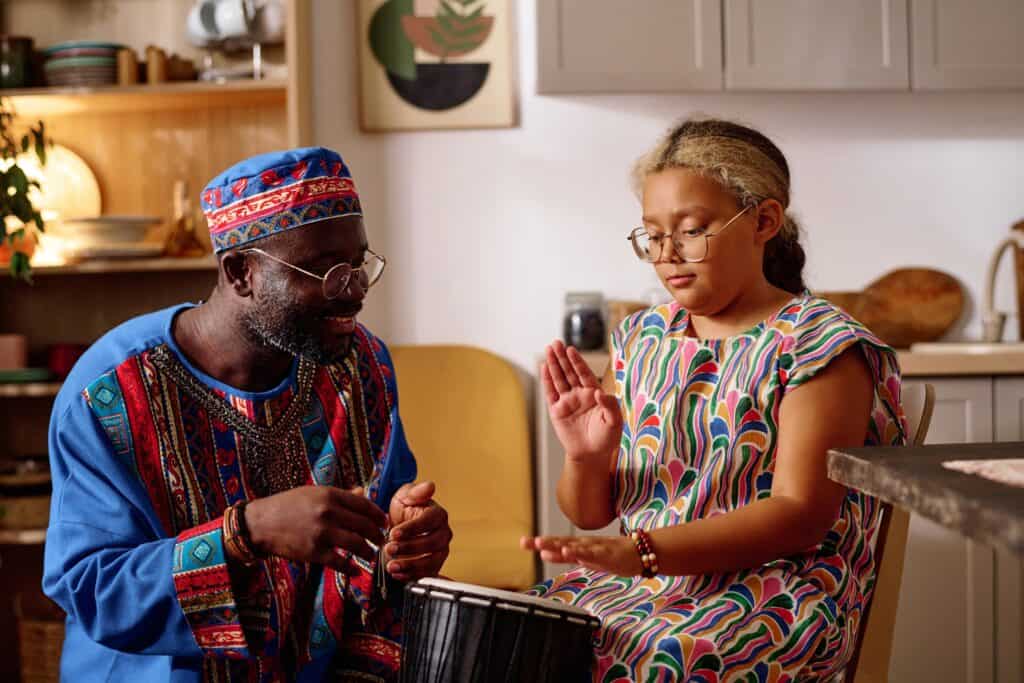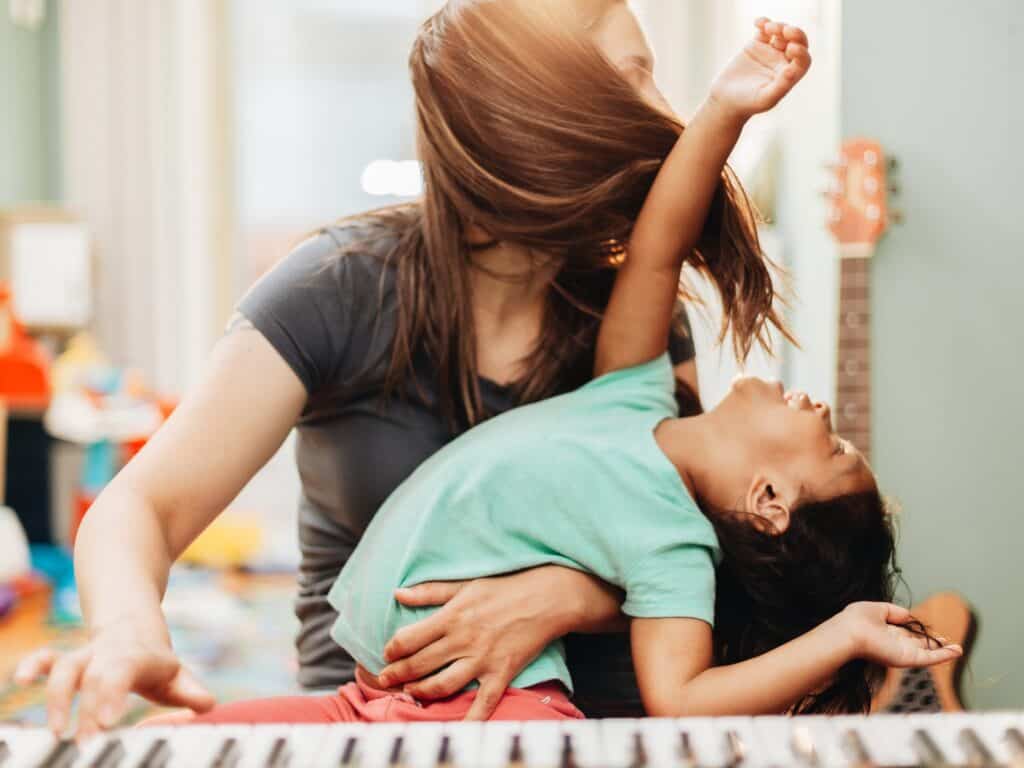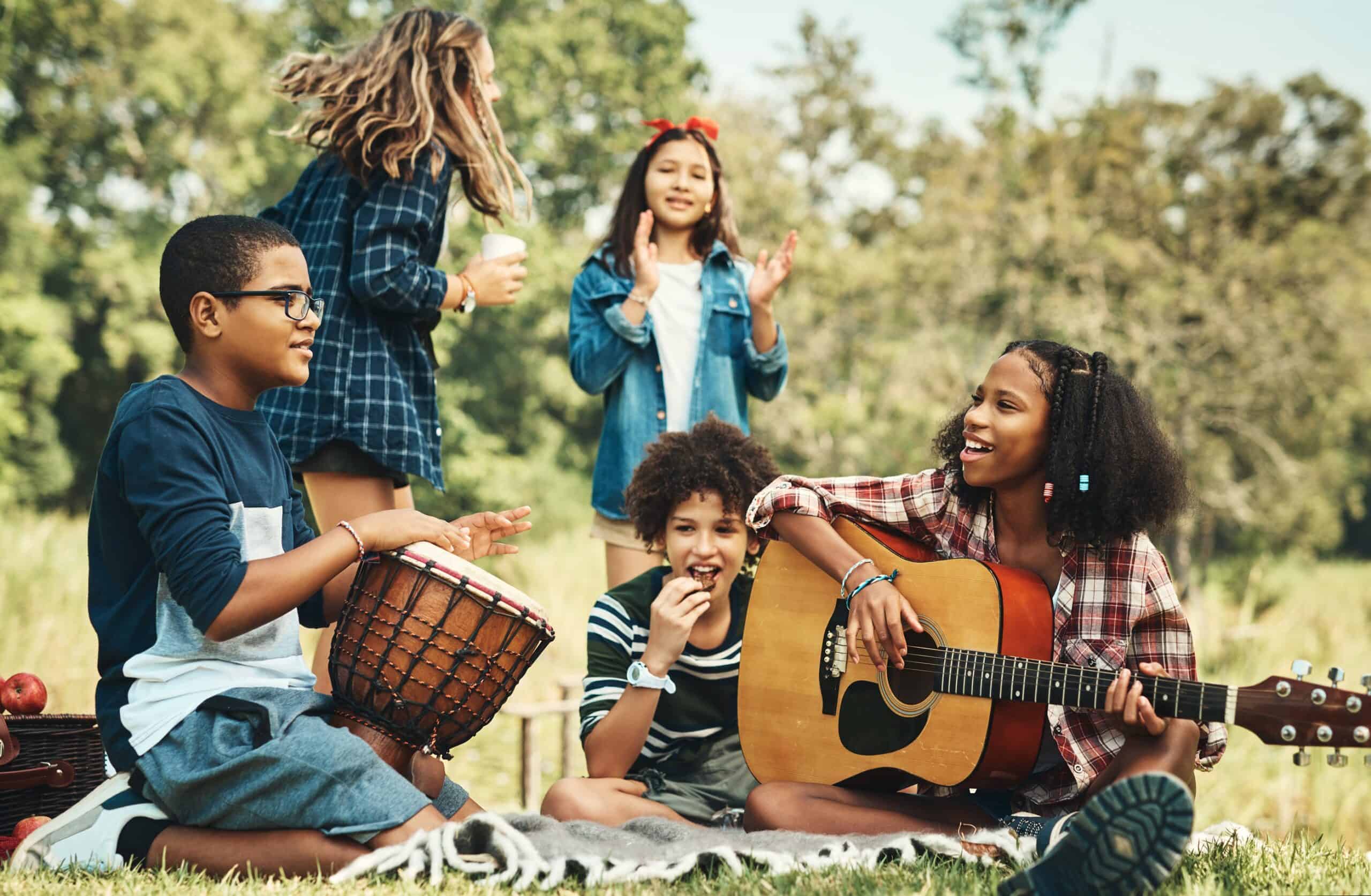Have you ever noticed how a song or a simple movement can lift your mood?
For neurodivergent individuals, these creative tools can do so much more – unlocking self-expression, fostering growth, and building meaningful connections. Neurodiversity highlights the wide range of cognitive variations in individuals, including autism, ADHD, and dyslexia. While these differences often come with challenges, they also bring unique perspectives, creativity, and problem-solving abilities. As society evolves to appreciate these strengths, music and movement have emerged as transformative tools that increase neurodivergent individuals’ potential and foster inclusive communities.
The power of creativity lies in its universality. Music and movement transcend linguistic and social barriers, allowing neurodivergent individuals to express themselves authentically. Research and real-world applications increasingly demonstrate how these modalities enable growth, self-discovery, and connection.
Neuroscience Insight
Creativity taps into the brain’s unique ability to adapt and grow. Research shows that music and movement activate multiple brain areas simultaneously, increasing motor, emotional, and cognitive connections. For instance, rhythmic activities improve coordination and memory while reducing anxiety and stress. These therapies engage the body and nurture the mind.
Music Therapy for Neurodivergent Individuals: Connection and Growth

Music is deeply woven into human culture and communication. For instance, for neurodivergent individuals, music is not just a form of entertainment but a channel for connection, personal expression, and development. Research continues to validate its therapeutic benefits, particularly in addressing the unique challenges neurodivergent individuals face.
Music engages multiple areas of the brain
Thanks to that, music is stimulating emotional and cognitive regions in ways other interventions cannot. Neurodivergent individuals, particularly those with autism, often face difficulties in expressing emotions or engaging socially. Structured music therapy provides a nonverbal medium for expression, enabling these individuals to connect with others meaningfully. For example, rhythmic exchanges like drumming in a group setting create shared experiences, fostering cooperation and empathy.
Music therapy has many benefits
Children especially benefit from early exposure to music therapy. Studies show that group musical activities, such as singing or simple instrument playing, increase a child’s ability to interpret social cues. This is important for fostering relationships and building communication skills during formative years.
Music supports cognitive growth
This is visible particularly in areas like memory and executive functioning. Songs with repetitive patterns, rhymes, or melodies can strengthen neural pathways associated with these skills. For individuals with ADHD, music can help regulate attention and manage hyperactivity, providing both stimulation and a calming effect.

Music improves self-regulation
A 2023 study reported that neurodivergent children exposed to music therapy exhibited improved emotional self-regulation and reduced anxiety levels. This aligns with findings that rhythmic entrainment – synchronising the body’s internal rhythms to external musical beats – stabilises heart rates and induces relaxation.
Personalisation is the key
Tailoring musical interventions to individual preferences is very important. Neurodivergent individuals often respond strongly to specific genres, tempos, or instruments. For example, therapists can use these preferences to design engaging, personalised sessions, making therapy both enjoyable and impactful.
Music evokes memories
For children, incorporating familiar songs or melodies associated with positive memories can make therapy sessions feel safe and enjoyable. Additionally, activities such as creating custom playlists or composing simple tunes together also encourage active participation and creativity.

Benefits of Movement Therapies for Neurodiverse Children
Movement therapies like dance, yoga, or playful exercises address a wide range of needs in neurodivergent individuals. These activities promote physical wellbeing, sensory integration, and emotional resilience while fostering a sense of freedom and agency.
Physical movement and coordination
Physical movement is vital for overall health, but its benefits extend far beyond fitness. For neurodivergent individuals, movement helps improve coordination, balance, and spatial awareness. For instance, Dance Movement Therapy (DMT), combines physical activity with emotional expression, enabling participants to better understand and navigate their bodies.
Boosting brain function through movement
Movement also stimulates brain regions responsible for motor planning and coordination. Activities like jumping to rhythmic beats or stretching in synchronised patterns increase neural connectivity, promoting better motor control. Additionally, movement activities can double as a playful outlet for stress. Play-based interventions, such as dancing games or obstacle courses, create joyful opportunities to develop emotional regulation skills while having fun.
Making therapy engaging and fun
It’s important to remember that children benefit significantly from movement-based therapies that combine physical activity with fun. Simple actions, such as hopping or clapping along to songs, can strengthen gross and fine motor skills while keeping engagement high.
A nonverbal outlet for emotional expression
Many neurodivergent individuals struggle with verbal communication, making it difficult to express complex emotions. Movement offers an alternative form of expression, enabling participants to “speak” through their bodies. Simple acts like swaying, tapping, or spinning can reflect moods and feelings that words cannot capture.
PAUSE AND REFLECT
Think of a time when music or movement shifted your mood – perhaps a calming tune during a stressful moment or an energising walk on a difficult day.
How might these simple, creative tools provide the same sense of balance for someone navigating unique challenges?
The Synergistic Power of Music and Movement
When combined, music and movement amplify their individual benefits, creating a multi-sensory experience that engages the body and mind in harmony. This combination is especially effective for neurodivergent individuals who benefit from interventions that stimulate multiple senses simultaneously.
Promoting neuroplasticity
Research highlights how synchronised music and movement can promote neuroplasticity – the brain’s ability to adapt and rewire itself. For example, dancing to music activates both motor and auditory brain regions, increasing their connectivity. This improves skills like coordination, memory retention, and problem-solving.
Encouraging learning and cooperation
Interactive group programs for children, such as rhythm-and-movement games, foster both learning and cooperation. Similarly, activities like following a rhythmic pattern with drums or mimicking dance steps improve cognitive flexibility while encouraging peer bonding.

Strengthening social bonds
Music and movement together create communal experiences that strengthen social bonds. Group activities like drumming circles, dance classes, or rhythmic games encourage participants to collaborate and respond to one another. These interactions help neurodivergent individuals practice turn-taking, listening, and empathy in a low-pressure, enjoyable setting.
Fostering creativity and self-expression
The fusion of music and movement fosters creativity by encouraging improvisation and exploration. Neurodivergent individuals often excel in innovative thinking, and these activities provide a safe space for them to experiment and express their ideas freely.
Nurturing innovation
Creative movement exercises for children, like improvising dance moves or writing a simple song with peers, nurture their natural curiosity and ability to think outside the box.

Practical Recommendations
Using the transformative power of music and movement requires intentionality, planning, and collaboration among caregivers, educators, and therapists. Here are some actionable strategies to implement these creative tools effectively:
1. Customise interventions
Recognise that every neurodivergent individual has unique needs, preferences, and sensitivities. Tailor activities to match their sensory profile. For instance:
- Use soft, soothing music for individuals sensitive to loud sounds.
- Incorporate familiar or favourite songs to create a sense of comfort.
- Adjust movement intensity to align with their energy levels and physical capabilities.
- Incorporate storytelling or character-driven activities – such as pretending to be animals while dancing – this can make sessions more relatable and engaging.
2. Maintain structure and routine
Establish predictable schedules for music and movement sessions. Familiarity builds trust and reduces anxiety, enabling individuals to engage more fully. Incorporating rituals—like starting each session with the same song or activity – can help participants transition smoothly into creative tasks.
Children benefit from routine, so including rituals, such as a welcome song or farewell activity, adds structure and increases their sense of safety.
3. Integrate creativity across environments
Extend music and movement beyond therapy into daily life. For example:
- Introduce rhythmic games during classroom breaks.
- Use movement-based exercises to teach academic concepts, like clapping out syllables in a reading lesson.
- Incorporate dance breaks at home to reduce stress and improve focus.

4. Encourage social participation
Group activities provide opportunities for neurodivergent individuals to build relationships and practice social skills. Therapists and educators can design inclusive group sessions where participants collaborate on shared musical or movement-based projects.
5. Leverage emerging technologies
Technological advancements like virtual reality (VR) offer new ways to deliver these therapies. VR environments can simulate immersive experiences, enabling neurodivergent individuals to explore music and movement in personalised, controlled settings. A 2023 study found that VR-based interventions increased empathy and understanding among neurodiverse groups by creating interactive experiences that mirrored their sensory worlds.
Cultural Connection
In many cultures, music and movement are integral to healing and community building. For example, African drumming circles foster collective rhythm and connection, emphasising shared experiences over individual performance. This approach mirrors how music and movement therapies create inclusive spaces for neurodivergent individuals to express themselves and build relationships.

Challenges and Future Directions
While the benefits of music and movement therapies for neurodivergent individuals are well-documented, several challenges hinder their implementation. Addressing these barriers and exploring future opportunities will ensure these interventions reach their full transformative potential.
Many families face financial and logistical barriers to accessing music and movement therapies. Expanding funding through public health initiatives, private sponsorships, and government support is essential to make these therapies available to all. Despite growing awareness of neurodiversity, societal stigma persists, often marginalising neurodivergent individuals and undervaluing creative therapies. In addition, misconceptions about their efficacy or relevance can deter schools, workplaces, and families from embracing these interventions. Targeted education campaigns and advocacy efforts can shift public perceptions, highlighting the strengths of neurodivergent individuals and the value of creative approaches in fostering growth and connection.
More research is needed
The variability in how music and movement therapies are delivered presents a challenge for assessing their effectiveness. While existing studies support their benefits, more robust research is needed to establish standardised methodologies and measure long-term impacts. Collaborative efforts between researchers, practitioners, and neurodivergent individuals can create evidence-based guidelines that ensure consistency and effectiveness across diverse settings.
The path forward lies in expanding the reach and impact of music and movement therapies through collaboration and innovation. Overcoming challenges and embracing future opportunities can help us use the full potential of music and movement therapies. Above all, these creative interventions have the power to transform lives, enabling neurodivergent individuals to thrive and fostering a more inclusive, compassionate society.

Free Tools to Support Creativity, Regulation, and Inclusion
Music and movement open doors for emotional growth, cognitive development, and community connection—especially for neurodivergent individuals. These carefully designed free resources and companion articles extend the benefits of this article into your everyday life, home, classroom, or therapy space.
Free Resources to Try Today
- 8 Senses Scavenger Hunt — A playful activity that integrates sensory processing, body awareness, and movement exploration.
- Incorporating Music into Daily Activities — A practical guide for weaving rhythm, melody, and sound into daily transitions, routines, and learning moments.
- Learning and the Brain — A printable that explains how the brain learns through multisensory experiences, ideal for understanding how music and movement enhance memory, attention, and emotional safety.
- Friendship Recipe Cards — Use music and movement sessions to practise the ingredients of social connection: turn-taking, kindness, humour, and shared joy.
- Play Ideas from Around the World — Bring culturally diverse games and rhythms into your space to celebrate movement, cooperation, and belonging.
All resources are free to our subscribers. Sign up here to download and share them with your community.

Related Articles for Deeper Learning
- The Power of the Hero’s Journey in Teaching Kids About Resilience – Explore how storytelling help neurodivergent children see themselves as courageous and capable.
- Understanding Challenging Behaviours in Children – Learn how sensory sensitivities and self-regulation difficulties may be expressed through behaviour—and how to support safe expression.
- The Science of Emotional Resilience – Discover the neural benefits of compassion-based practices for reducing stress and building inner strength.
- Empathy Milestones: How Empathy Develops from Infancy to Adolescence – Understand how emotional expression helps build empathy and social awareness across developmental stages.
Together, these tools honour the full sensory, cognitive, and creative brilliance of neurodivergent minds—while helping caregivers, educators, and therapists create inclusive environments where all children can thrive.
Final Thoughts
In conclusion, music and movement are bridges to connection, self-expression, and empowerment for neurodivergent individuals. Embracing these creative modalities can help us tap into the unique strengths of neurodiversity and foster inclusive environments where everyone can thrive.
Addressing barriers such as accessibility, stigma, and the need for research will expand opportunities for these interventions to transform lives.

Reflect
What’s one way you’ve used music to connect with someone?
Take a moment to reflect and share this article with someone who might find it inspiring.
References:
- Cherewick, M., & Matergia, M. (2023). Neurodiversity in Practice: a Conceptual Model of Autistic Strengths and Potential Mechanisms of Change to Support Positive Mental Health and Wellbeing in Autistic Children and Adolescents. Advances in Neurodevelopmental Disorders, 8(3), 408–422. https://doi.org/10.1007/s41252-023-00348-z
- NeuroLaunch.com. (2024, August 28). Autism and Music: How autistic children respond to melodies. https://neurolaunch.com/do-autistic-kids-like-music/
- Lisboa, T., Shaughnessy, C., Voyajolu, A., & Ockelford, A. (2021). Promoting the musical engagement of autistic children in the early years through a program of parental support: an Ecological Research study. Music & Science, 4. https://doi.org/10.1177/20592043211017362
- Megan Rhiannon (2020). Creative Differences: A handbook for embracing neurodiversity in the creative industries (Second edition), Universal Music.
- Kaur, H. (2023). Finding resilience through music for neurodivergent children. In OCAD University, OCAD University. https://openresearch.ocadu.ca/id/eprint/4161/1/Kaur_Harkirat_2023_MDes_INCD_MRP.pdf
- Mason, A. S., Sonke, J., & Lee, J. (2021). Drum circles and the effect on wellbeing in a community setting. UF Journal of Undergraduate Research, 23. https://doi.org/10.32473/ufjur.v23i.128335
This piece was written for you by
A Specialist in Music, Culture and Child Development / Chief Creative Officer at Neuro
Monika is a specialist in music, culture and child development, dedicated to exploring how music shapes cognitive growth, language acquisition, and emotional wellbeing. She guides parents and educators in using the power of music to support children’s learning, growth and creativity. At Neuro, she contributes research-driven content that connects neuroscience, education, and the arts, fostering a deeper understanding of music’s role in holistic development.
